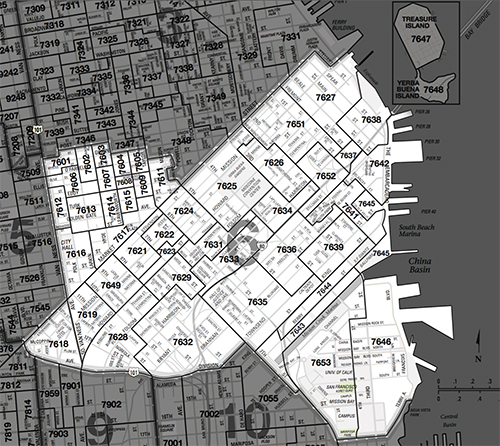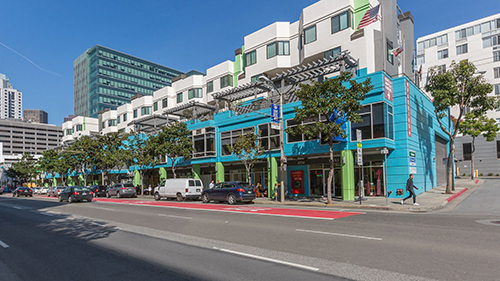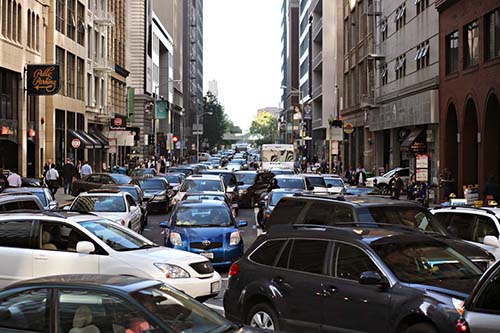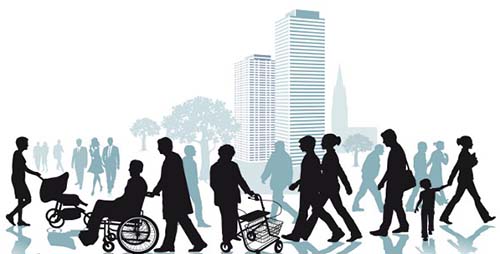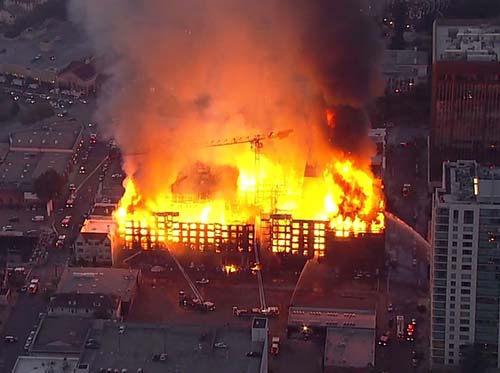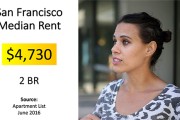
Sonja Trauss: Pro-Housing SF Candidate Advocates for Affordability
by Rebecca Firestone with Mark English AIA | Interviews
“San Francisco’s old guard wants to keep you out by preventing you from finding housing, which is driving rents sky-high. Why would you want to vote for them?”
In the past, we at The Architects’ Take have often advocated for urbanism beyond the individual building. Urbanism involves a myriad of approaches: repurposing of old buildings to serve new purposes, creating great public spaces, promoting environmental sustainability, increasing safety and accessibility, and breathing new life into dingy and un-livable districts.

Linden Alley in San Francisco was DIY improvement, where neighborhood locals took it upon themselves to improve what had been a dilapidated, trashed alleyway. Photo: David Winslow
Architects have advocated for the “greening” of cities, and for walkable downtowns to replace a car-centric grid that discourages all other uses. We’ve explored the implications of rebuilding after natural disasters, and how design can re-create neighborhood social fabrics – or destroy them.
These planning tasks have often fallen squarely in the laps of architects, among others. The “others” would be essential members of the team as well: city planners, lawmakers, neighborhood groups, and yes, developers who are willing to put up the necessary funding when municipal coffers can’t handle it alone.
Campaigning for Supervisor of San Francisco’s District 6 is a face that should be familiar to our readers by now: Sonja Trauss, founder of SF-BARF, a pro-density and pro-housing advocate, is throwing her hat into the ring as an agent of positive change.
What’s her core message? “Safe and clean streets, housing for the homeless, and responsiveness to constituents,” she replied.
Why should architects and design professionals care about your candidacy?
San Francisco has an ambivalent relationship with good design. There’s a process for design review, and yet, the public seems dissatisfied with the look of the new housing, and architects are frustrated by the process. So something isn’t working.
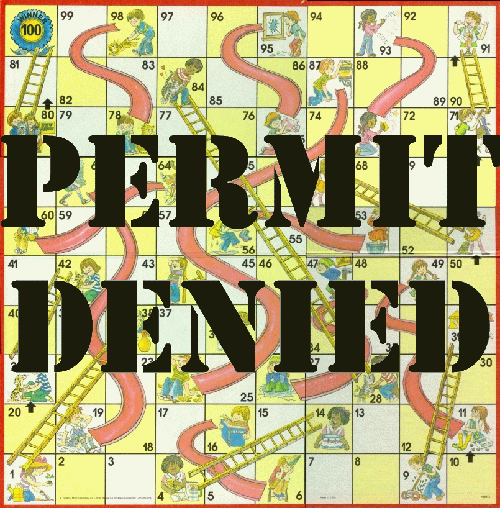
Getting a Planning approval and a building permit in San Francisco could be compared to a game of Chutes and Ladders… with greased rungs. The design review process is capricious, with no accountability. It doesn’t matter that the last guy said to do something different.
We have design review, and yet the average person on the street complains that they “don’t like the buildings” – they’re surprised to learn that we even HAVE design review! Architects want to build things, and do a good job. They have a wide body of knowledge on how to make great spaces. That’s what they went to school for!
How optimistic are you about gaining a Supervisor seat?
Whether I win or not depends… if I do win, that’s another indicator that we’re onto something, that there’s more widespread support for building the City.
What other issues are important for District 6?
District 6 has seen a lot of retrofitting of of infrastructure. Originally, the area was dedicated mainly for manufacturing. Now, that’s changing as the area is becoming more and more residential, to accommodate some of the tens of thousands of new people who have moved to San Francisco in the past 10-20 years.
It still has a lot of 1-2 story buildings, with a lot of 4-6 lane streets where people are driving at 55 mph. Narrow sidewalks, no bike or transit lanes. It’s all cars, and parking. This was fine for manufacturing when fewer people lived there. It doesn’t make for a great quality of life as a residential neighborhood.
Driving in SoMA really sucks, especially at rush hour.
SoMA is varied this way. From 3pm-7pm getting on the freeway is bad. It’s infuriating seeing gridlock. And it’s dangerous, for pedestrians, cyclists, and cars alike. Neighbors here have been asking for years for traffic cops, and haven’t been getting them. Driving in SoMA is OK most of the time.
We have to adjust people’s expectation. People expect to drive 35-50 mph all over town. That’s not reasonable in a city. You should expect to be able to go 25 mph, but it should be a reliable 25 mph without gridlock or unexpected delays.
The point of bringing a car into the city is not to go fast! That’s not why you should choose to do that. You should bring a car in if you need to carry heavy stuff, or you’ve got a group of kids, or you’re disabled and really need to bring your car.
It’s more important to have a predictable commute, so that people know how long it’ll take them to get to work every day.
There should be a built-in predictability for each mode of transport. If you’re walking somewhere, it’s a known distance, you should know how long that takes. Same with biking. It should be the same with a bus, or Bart, or driving.
So what would you change?
Narrower streets, bigger sidewalks, bike and bus lanes, and 2-way streets. Not 4 lanes of traffic in one direction. Better public spaces and better general amenities.
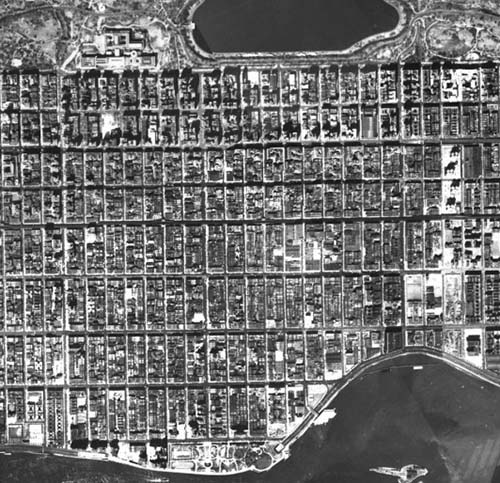
A grid pattern with streets that go through can distribute traffic flow. Shown here: Manhattan, which is high density and still walkable.
There are two philosophies of street design. The first is many narrow streets that all go through, so that traffic is distributed. That’s the one I favor. The other, which is what the City of Berkeley did, is to have a smaller number of arteries, all through traffic is funneled into those, with the remaining streets all dead-ended. Berkeley basically destroyed their grid for cars.
What’s your view on how to tackle homelessness in San Francisco?
It’s a twofold failure: a failure of the City system to produce enough housing, and it’s also a healthcare failure. Some of the people on the street now would not be there in different times. In 1978, they’d be at SF General [ hospital ], receiving continuous care.

It’s so bad that even fully employed workers are living in boxes inside other people’s apartments… and paying rent! Photo: Peter Berkowitz
These are people who should be, or were, living in single-room occupancy units [ SROs, aka “residential hotels” ]. People on fixed incomes, who can afford some rent, just not market rate. However, the SROs now have young people living in them, people making $30-$40K a year, who would normally be renting 1 bedrooms. They can’t, because those now rent for $3K a month, and the next tier up is in those. They’d normally be in 2 bedrooms but you can’t build those, because you can’t build anything. And why can’t you build? Because we have naysayers who want to preserve neighborhood character, and god forbid we build a 4-story building in a 2-story area!
Homelessness is thus a cascading effect of the housing shortage.

Low-income people are being pushed out of the low-end housing stock by middle-class workers who are moving into what little is left. Meanwhile, San Francisco activists are working tirelessly to prevent them from having any other places to live. So, what happens to the folks on fixed incomes?
What’s the City doing, then?
The City’s response to homelessness is to prioritize what’s called “housing first” which is to focus on building supportive, subsidized housing for the neediest populations. This is good. However, the scale is totally insufficient.
In San Francisco, an estimated 7,000 people sleep outside every single night. That’s our backlog. That’s the line of people currently waiting for housing. The Department of Homeless Services states that we’d need to add 1200 new units of housing a year just to keep pace with current needs. Instead, we’re building maybe 300 units a year.
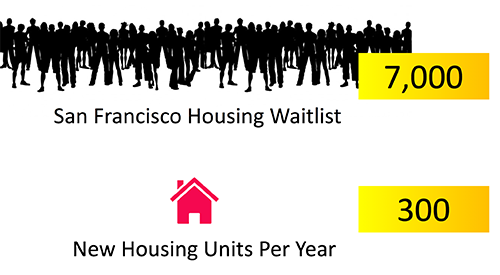
San Francisco’s Department of Housing Services needs 1200 new housing units per year, just to house people who are waitlisted for affordable housing. Instead, the City is allowing maybe 300 units per year to be built.
The City has refused to recognize that there’s a line of waitlisted people who need housing. In fact, the City of San Francisco is paralyzed. They’re essentially condoning the tent cities under the table, while refusing to acknowledge that they’re doing so. City employees, social workers, are telling people to go live on the street. At the same time the City refuses to provide services to the tent cities because it would be “institutionalizing” them.
For the tent cities, why not provide services? Port-a-potties and sanitation? They’ve got this notion that formally recognizing the tent cities would be not just condoning them, but institutionalizing them. The fact is, those tent cities are already institutionalized. They are the result of every year that we don’t build 1200 new housing units.
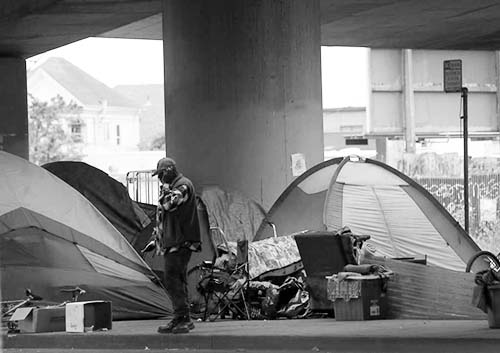
Unlike San Francisco, the City of Oakland is admitting that it needs to provide services to homeless encampments. Photo: Paul Chinn for the SF Chronicle
The City of San Francisco is pushing people out onto the street. The City has “navigation centers”, where people who are homeless can come and get services. Of these, maybe 30% find housing, 40% go to another town, and 30% who are still there after 60 days, they go back out on the street. The City employees, social workers, are saying this to people, to go live on the street.
This is a gap in services. The City needs to fill this service gap. If the City can’t find room or money to build indoor spaces, while people are waiting for permanent housing, here’s a proposal: The Metropolitan Transit Authority (MTA) owns 20 parking garages which are under-utilized. They could dedicate say the top level of one of these garages to a safe, clean, secure camping zone. They’re sleeping outside anyway. Provide trash pickup, social workers, security, sanitation.
Being homeless is a huge source of stress, and affects even the most robust individuals’ capacity to function. You need to have somewhere to put your stuff, or carry it around with you literally all the time. If you’re in this situation, any other disruption – health issues, for example – can be catastrophic.
Most people are homeless for only 4 months. That’s a national statistic. It’s a sign that, nationally at least, programs are working.
What do you think about the Occupy movement?
It’s great. It really inspired me. I spent a lot of time at the Oakland tent city, not necessarily helping out or organizing, just being there. It was a well-curated tent city encampment.
The philosophy was one of showing up. Saying “Shit is fucked up and bullshit! I don’t know what to do about it, but just… SHOW UP.”
That’s exactly how I felt with SF BARF and the Bay Area housing shortage. It’s fucked up. And nobody was doing anything. Our approach was to go down to City Hall, to the Planning Commission, with a few people and say, over and over, “We need more housing. What’s the problem? Why can’t we build more housing?”
How can we tell a story that will convince people in, say, Los Altos, that their refusal to allow one new luxury apartment building in THEIR town is actually impacting people like me in Oakland?
Don’t try to tell fact-based stories. People don’t want to hear “facts”. Instead, I tell question-based stories. Try to draw them out about why they feel that way. People will start to hear themselves revert to absurd claims.
For example, let’s take that theoretical apartment building. Let’s say it’s 4 stories tall, in an area of single-family homes. When you think about it, 4 stories isn’t all that tall. And let’s say that the person objecting to a new apartment building has been living contentedly on their property for 40 years. You could start by asking the person, “So, where do you think those people will live?” And the person might respond with, “Who cares? That’s not my problem.” And you could say, “So you have a public policy of ‘don’t’… well, please make a complete public policy proposal.”
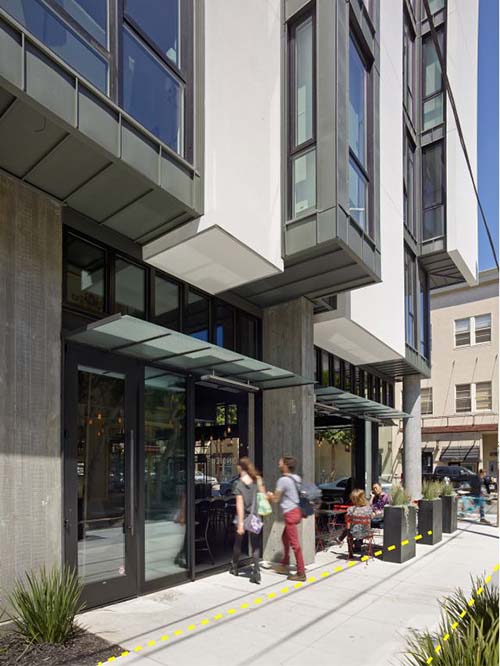
Architect David Baker’s concept of the “Q Zone” says that the first 30 feet up are the most important for walkable cities, to welcome people in and get them to interact. Can you tell how high this building is? It could be 3 stories, or 50. Photo: Bruce Damonte for David Baker Architects
Another common objection is, “Well, developers are just here to make money.” So you have to start by asking, “So how do they make money? Does it fall from the sky? No… somebody pays them. Tell me about that person who’s paying the developer. Who is that? A buyer, right? Well, where do you think those buyers are going to live, the ones who would have lived in that building? Are they going to live 2 hours from their jobs, because you don’t want to see new housing go up down the street from your place?”
Or, let’s say the proposed apartment building is actually somewhere on the Peninsula in a downtown location, near a transit hub. You can also ask people, “So what’s really the downside here, to building this new apartment building in your downtown, 5 miles from your house? How is that really going to affect your life? Does that make sense, that your feelings are more important than allowing someone to live near their work?”
What are some of the most common objections you run into?
Objection #1: New buildings will increase rents.
If the proposed housing is in a poor neighborhood, objections consist of “New building will increase rents.” That’s not true, though – developers don’t build in areas with lower rents. They build in areas where rents are ALREADY rising. Developers have to get financing. Banks won’t loan them money unless they can show that median rents ALREADY justify new investment.
There’s also the argument that there are already no low-rent neighborhoods in San Francisco. Rents have already increased, even without new housing.
So why do people have the notion that new housing causes rent increases, that otherwise would not have occurred? Well, they see buildings go up, and they see rents rise at the same time. So they conclude that one is causing the other, when it’s really the other way around. Developers see the opportunity of rising rents, and that’s when they decide to build. [ correlation does not equal causation ]
It’s a false argument to begin with, and here’s some proof of that. I lived in West Oakland from 2011-2016. During that time, there were no new buildings, and rents were rising every year, by $100 a month. If new housing causes rents to rise, and nothing was being built in Oakland, why were rents rising in West Oakland?
Seacliff in San Francisco is another example. It’s one of the most expensive areas in the city, and there’s no new building going on. People seem to believe that not building new housing is all you need to do to keep rents from rising! If that were really true, the Bay Area would still have 1970s-level rents.
Objection #2: If we don’t build housing, all “those people” won’t move into our neighborhood.
Actually, they will, and they do. They’ll move into existing housing, cramming more people into the same 1BR apartment, subdivide their living rooms, or maybe they’ll start living in their vans.
Objection #3: The character of the neighborhood will change.
More Buddhism is needed. How bad is the impact really going to be, on your life? For most of us, life priorities are things like health, having a fulfilling job, kids and family. A 4-story building in your neighborhood won’t change any of your real priorities.

OMG a 4-story building in a 2-story neighborhood! The world will stop turning! Sonja Trauss: “Maybe you should see a therapist!”
Government needs to balance the needs of the entire population that it serves. If homeowners “feel sad” about the character of their neighborhood changing, the government shouldn’t necessarily be involved. Government interference in moral matters used to be more acceptable. Two men living together… let’s prevent them from marrying because it makes me “uncomfortable”. But gay people are citizens, too. Nowadays, we’d more likely say, “If you don’t like two guys pairing up, maybe you should talk about it with a therapist!”
What about your opposition?
City Supervisors are primarily interested in improving their district neighborhoods in ways that are important to their constituents. That’s the Supervisor’s job. Constituent services is an important part of this – making daily life easier and more pleasant.
I would say this to the voters: “My political opponents are trying to keep you out by preventing you from finding housing. Why would you want to vote for them?”
Any other message for TaT readers?
Architects and their clients are affected on a daily basis by NIMBYism and by a capricious, unreliable entitlement system. [ builders, too – the entire construction industry ] Architects went to school to gain specialized knowledge. They believe in what they do, and they want to USE their knowledge to improve the built environment, for everybody. Most architects want to make a great product. My message is that we should trust architects a little more, to do just that.

The Bay Area housing shortage is a regional problem, but every municipality is trying to push the problem “someplace else”.
Links
Sonja Trauss and BARF
- Sonja Trauss campaign web site
- BARF! Density-loving Sonja Trauss is running for District 6 supervisor, SF Examiner, July 28, 2017
- A Reddit thread that quotes the above Examiner article: “A neoliberal candidate who has consistently placed herself on the opposing side of neighborhood activists and born-and-raised Frisco folk is not the person I want representing the hood that raised me,” Bakta told me.”
- The Reddit thread starts arguing about what “neoliberal” actually means, and cites 2 additional articles:
- A WaPo article “A Neo-Liberal’s Manifesto” from way back September 5, 1982.
Apparently neoliberal are not necessarily anti-capitalism, but are definitely anti-union and pro-military – just not heartless Ayn-Rand-ish Reaganite greed-heads. They want justice for all, and a longer-term view of profit that considers more than CEO and shareholder quarterly dividends. - The Wikipedia entry “Neoliberalism”. Says that it’s a muddy term, originally meant to describe free-market social progressives.
- A WaPo article “A Neo-Liberal’s Manifesto” from way back September 5, 1982.
- “Prominent San Francisco YIMBY advocate Sonja Trauss is running for office”, The Architect’s Newspaper, July 18 2017
- In Cramped and Costly Bay Area, Cries to Build, Baby, Build, NY Times, April 16, 2016
- From AngryRenter to SFBARF: Co-opting Tenants for Political Gain, Medium, October 30, 2015. Basically compares Trauss to Dick Armey. Attacks luxury housing developers. Views North Beach’s anti-development activist and City Supervisor Aaron Peskin as a tenant ally.
- How a prep school math teacher has exploded the debate over affordable housing in San Francisco, Washington Post, February 9, 2015
- Not building enough housing is morally equivalent to tearing down people’s homes, Greater Washington, January 5, 2016. “Most people would be very uncomfortable tearing down 315 houses. But they don’t have a similar objection to never building them in the first place, even though I feel they’re morally equivalent. Those people show up anyway. They get born anyway. They get a job in the area anyway. What do they do? They live in an overcrowded situation, they pay too much rent, they have a commute that’s too long. Or maybe they outbid someone else, and someone else is displaced.” – Sonja Trauss
- San Francisco Bay Area Renters’ Federation, Wikipedia entry: No, she’s not funded by evil developers.
- SF YIMBY Party (Yes in My Backyard)
Articles on Bay Area Homelessness and Housing Shortage
- The big lie about California’s housing crisis, SF Examiner, July 28, 2017. Says we need affordable housing, not rely on free market, and that most builders and landlords are now mega-corporations.
- In Stunner, City Strikes Down Major Mission Project, Mission Local, November 2016
- “The carrots and sticks BART is using to manage homeless population”, San Jose Mercury News, July 30, 2017
- “Instead of clearing homeless camps, Oakland is spiffing them up”, SFGate, October 19, 2016
- “Homeless tent camps sprouting all over Oakland” SF Chronicle, July 31, 2016
- In pricey Bay Area, some turn to vans for cheap living quarters, Washington Post, June 3, 2016
- “Rent this van to live at Google and ‘eat Google food’ for $30 a day”, SFGate, April 27, 2016
- “City-sanctioned homeless campground coming to Oakland”, San Francisco Chronicle, March 26, 2017
- The Yelp employee who wasn’t making enough money to eat, Washington Post, February 23, 2016. She got fired for blogging about how little Yelp was paying. “You paid $300M for a food delivery app and can’t afford to pay me a living wage…”
Arson and Fires in Oakland
- “Arson in Oakland: Is Someone Torching New Developments?” East Bay Express, July 7, 2017
- “ATF: 2016 fire in Oakland was 4th arson at unfinished building”, SFGate, July 7, 2017
- “4 fires, 4 arsons at half-done housing sites in Oakland” San Francisco Chronicle, July 7, 2017
- In addition to suspicious fires at construction sites, Oakland has seen several large fires at residential buildings, not all of which were legal. The Ghost Ship warehouse, where almost 40 people died, has led the City of Oakland to crack down on other “illegal” warehouses. Instead of working to bring these buildings up to code, Oakland opted for further displacement of artists.
References to Other Articles on The Architects’ Take
- “Kearstin Dischinger: Policy Planning and Bay Area Housing” on The Architects’ Take, March 14,2017
- “Craig Hamburg: Developer, Citizen, Urbanist” on The Architects’ Take, October 18, 2016
- “David Winslow on the Guerrilla Urbanism of DIY Neighborhood Improvements” on The Architects’ Take, August 31, 2016
- “New Orleans Post-Katrina: Making It Right?” on The Architects Take, January 25, 2011
Walkable Cities
- “Walkable Cities Mean Safety and Socialization for Aging in Place”, on Senior Care Corner
- “Stepping into the Q Zone”, blog entry from David Baker Architects
Photo Notes
- Police pepper spraying Occupy student protesters at UC-Davis campus on Nov of 2011
“Documents reveal UC Davis spent $175,000 to erase pepper-spray incident from Internet” - “Homeless tent camps sprouting all over Oakland” SF Chronicle, July 31, 2016. Photos by Paul Chinn.
- “Instead of clearing homeless camps, Oakland is spiffing them up”, SFGate, October 19, 2016. Photos by Liz Hafalia and Michael Macor.
- “Rent this van to live at Google and ‘eat Google food’ for $30 a day”, SF Gate, April 27, 2016. Photos by Robert Allen and Peter Berkowitz.
- Occupy, “Shit is fucked up and bullshit” photo

